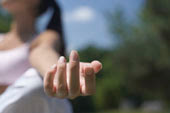 At one time it seemed that yoga was little more than a dated hippie fad, rather like the lava lamp. But now this ancient health system is back in vogue.
At one time it seemed that yoga was little more than a dated hippie fad, rather like the lava lamp. But now this ancient health system is back in vogue.Celebrities such as Gwyneth Paltrow, Madonna, and Julia Roberts and Sting are not shy about advocating the mental and physical benefits of the discipline.
It is cool to carry around a little purple mat and tie yourself up in knots in local gyms and draughty church halls. It seems yoga is everywhere, and nowhere is it more omnipresent than on the net.
Should you wish to learn more about Sting's views on the subject, for instance, you might care to read the in-depth interview available at the White Lotus website.
You'll find a glossily professional web page which features authoritative articles on the many different forms of yoga - and the debate about which is the best.
You can also access a shop selling books and videos, or click through selection of celebrity interviews.
Share the well-illustrated interview with Sting, in which he expresses regret at not having started yoga earlier. But he adds that, if anything, the exercise seems to be reversing the ageing process.
This view is echoed by fellow megastar Madonna. Indeed, the title song, Ray Of Light, in her best-selling album incorporates a traditional yoga chant.
If you are moved to discover more details, Roots And Wings, a 'yoga, bodywork and natural healing centre' will be happy to provide you with the original Sanskrit text of that chant.
Roots And Wings is largely geared to selling yoga products, but you'll also find articles, discussion groups and a search engine for locating those all important Sanskrit lyrics (just type in Madonna).
Another site, called Evolution, describes itself as an online yoga magazine, and although it can be a little graphic-heavy and slow, it's a snazzy and informative creation.
The visitor is offered enticements such as a free email newsletter, meditation advice, chants and even recipes.
Should you find Evolution's animated yoga girl icon annoyingly limber, you might be tempted to compete with her by practising a selection of yoga postures yourself.
Evolution allows you to call up these postures on your screen.
It seems that cyberspace is not yet the proper place to learn the subtleties of this ancient discipline: for that you'll still need to take a traditional class with a teacher.



